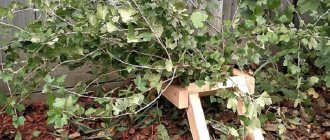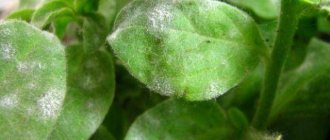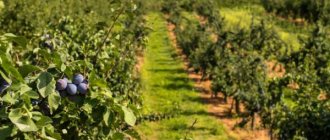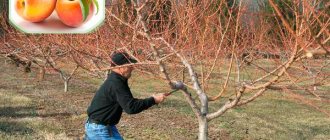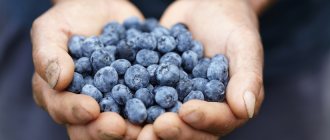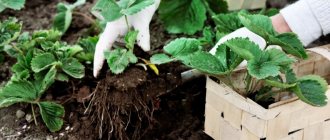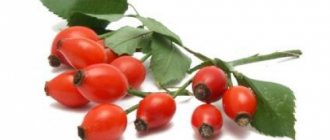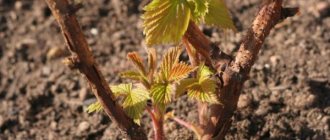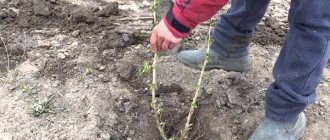Among all the diseases of gooseberries, powdery mildew will undoubtedly take the first place. This is a fungus that readily reproduces in the garden, on the site and even at home. Sooner or later every gardener will encounter it. Therefore, we have already learned the secrets of effective prevention and treatment. We share the best control measures!
Reasons for appearance
Even short-term changes in temperature and humidity are enough for powdery mildew to appear. During the spring, the fungus wakes up after the cold, and by the beginning of summer it rapidly spreads throughout the garden. Its appearance is promoted by weakened immunity due to improper care, radical pruning or other diseases.
How to recognize the disease
Powdery mildew can have different pathogens, but this does not change the course. Gooseberry leaves are covered with a whitish coating that seems velvety. But we do not recommend touching it with your hands, because these are myceliums, which are how the fungus reproduces.
Small spots first appear on the lower leaves and gradually become larger. Over time, they move on to young shoots and even gooseberries. The branches become bent, the leaves become smaller, the flowers do not form an ovary, and the fruits rot. Over time, wet drops appear on the powdery mildew spots, and then the plant begins to darken.
Ideal time to treat bushes
Powdery mildew can slowly plague the garden, depriving the summer resident of the desired harvest. Initially, the infection affects only young leaves and shoots, but then it destroys the fruits, spoils perennial branches and weakens the plant - parts of the bush turn noticeably white, and over time the coating turns brown.
How the disease spreads
The flowers fall off, the foliage withers, and the berries do not ripen, so it is necessary to wage a thorough fight against the invisible enemy.
- a dangerous fungus spreads through the air,
- but insects play a significant role in its life.
- and warm and rainy weather additionally creates favorable conditions for infection.
As a rule, powdery mildew makes itself felt already in the last days of May. Some gardeners are surprised to discover a problem in the summer, when the process of fruit formation has already begun and it is much more difficult to save the bush.
Time of processing
Cold weather is also not a hindrance for the fungus; it tolerates it well. The spores persist on the foliage and shoots, which is why spring treatment of the bushes is so important , it helps prevent trouble.
In order to permanently drive the malicious pest out of the garden, carry out several quick treatments of the bushes annually.
- come to the dacha before the buds open and the flowers appear,
- then treat the plants immediately after flowering,
- and don’t lose sight of the autumn event dedicated to the prevention of fungal disease.
But if you notice signs of powdery mildew on your gooseberries too late, don’t worry, but take action right now.
Chemicals: how to treat?
Powdery mildew often attacks plants - and this has a small advantage. The fungus has been well studied and specialized fungicides can effectively control it.
Copper sulfate
The universal component of most preventive and therapeutic products can be used in its pure form. For watering, dilute 100 g of vitriol in a bucket of water and mix well.
Bordeaux mixture
A real lifesaver for all gardeners will probably be found in your bins. The product helps well against dozens of fungi, diseases and other problems of gooseberries.
Fitosporin
This is the most popular biofungicide, which contains beneficial microorganisms that prevent the development of fungus. Its main advantage is its absolute non-toxicity, and gooseberries can be eaten after just a couple of days.
Gamair
Another biochemical drug that shows good results for treating gooseberry bushes from powdery mildew. Although the product is safe for people, strictly follow the precautions and instructions.
Planriz
The biofungicide is suitable for preventive treatment or if powdery mildew has already appeared. When used correctly, the drug does not affect the quantity and quality of the harvest at all.
Topaz
A universal fungicide prevents fungal spores from developing and spreading further. At the beginning of the season, Topaz is used for prevention, and then - when the first symptoms appear.
Fundazol
This is one of the best remedies for berry bushes, both for prevention and treatment. But a systematic approach is important, so the first treatment is carried out strictly before flowering, and the last - after harvesting.
Score
An effective broad-spectrum fungicide is good because it is not afraid of rain within a couple of hours after application. But it cannot be used immediately before harvesting - at least 3 weeks in advance.
Chemical sprays
If the disease is in an advanced stage, traditional methods may become ineffective. In this case, chemical preparations will come to the rescue; even after one treatment, they can cope with the problem and preserve all the gooseberry bushes.
How to fight fungus using chemicals:
- Dissolve 75 g of grated alkaline soap in 5 liters of warm water and gradually add 20 g of copper sulfate. The solution should be light blue in color and have a homogeneous composition. All shrubs should be treated before the flowering season begins or after fruit sets.
- Dilute the drug “Topaz” in accordance with the instructions in the instructions and carefully process the culture after the first flowers appear.
- Dissolve 40 g of the drug “HOMA” in 10 liters of water and irrigate the gooseberries once during the flowering period.
- Dilute 100-150 ml of “Fitosporin” with 8-10 liters of water and generously water the soil around the bush before it blooms and immediately after harvesting the fruits.
Folk remedies: how to fight?
If powdery mildew has just appeared, then minimal treatment is sufficient. However, folk recipes are also good in cases where you simply do not want to use chemistry. Just keep in mind that you will need more spraying!
Ash
Ash is the best preventative against most fungal diseases. Its infusion is a good antiseptic and additional nutritional supplement. A liter of boiling water will take half a glass of ash, and the solution needs to sit for a couple of days.
Green manure
An infusion of garden green manure is not only effective, but also convenient to use, because it is only grass and water. Take half a bucket of green manure, top it up with hot water and let it brew for a couple of days before processing the gooseberries.
Onion peel
Many summer residents develop the habit of always saving onion peels - they are so universal. And she has good success in the fight against powdery mildew. You need 200 g of husk per bucket of boiling water, and leave the mixture to brew for 2 days.
Mullein
This treatment combines the advantages of treatment and foliar feeding. To spray gooseberries, pour a third of a bucket of mullein with cold water and leave to infuse for 3 days, stirring occasionally. The procedure is best performed in the evening, when the sun is no longer aggressive.
Iodine
Pharmaceutical iodine is a good antiseptic and an effective drug for combating powdery mildew on gooseberries. You only need 10 ml per bucket of water, which you can measure with a syringe or simply add 10 drops.
Aspirin
Another pharmaceutical drug that helps in the treatment of gooseberries is aspirin. For a liter of water you need a crushed tablet, 1 tbsp. soda, a little liquid soap and vegetable oil. The main thing is to shake the solution well and use it throughout the season at intervals of 10-14 days.
Potassium permangantsovka
Another universal antiseptic is not just used for treating seeds and soil. When protecting gooseberries from powdery mildew, spraying with potassium permanganate also shows good results. You only need 5 g of product per bucket of water.
Kefir
Fermented milk whey with water in a ratio of 1:10 is a gentle, but almost miraculous remedy. Not only kefir is suitable, but also yogurt or sour milk.
Disease prevention
There are several preventive measures aimed at preventing the appearance and spread of powdery mildew.
Prevention consists of the following actions:
- Keeping the plantings clean. Weeds are removed as soon as they begin to appear, and the shoots are thinned out in a timely manner.
- When forming a berry garden, only varietal, zoned young plants are acquired. The place of purchase of planting material must be a certified nursery or garden center.
- Regularly prune the bush. It is not enough to cure the plant; the cut parts of the plant must be removed from the site and burned outside the territory.
- Another measure is cleaning the area ahead of the winter season. The soil around the tree trunk is thoroughly weeded, and a mulch layer is laid near the bush.
- You cannot “overfeed” with nitrogen fertilizers. They only stimulate the active growth of greenery and reduce the bush’s immunity. Potassium and phosphorus supplements will help strengthen resistance. Iodine also reduces susceptibility.
- Insect pests are dealt with in a timely manner. They are active carriers of spore infections.
Find out what to do if all the gooseberry leaves are eaten.
You can forget about powdery mildew if you grow gooseberry varieties resistant to fungi:
- Harlequin;
- African;
- Beryl;
- Grace;
- Grossular;
- Jocelyn;
- Carpathians;
- Kolobok (popular folk variety);
- Commander;
- Lada;
- Pearl;
- Spring;
- Pink;
- Russian;
- Sadko;
- Firework;
- Sirius;
- Houghton;
- Anniversary.
There are many methods for protecting gooseberries from this insidious fungus. Most of them have been proving their effectiveness for many years. All that remains is to choose a more suitable method and enjoy a tasty, rich harvest.
Prevention of powdery mildew on gooseberries
The fungus overwinters in last year's leaves and plant debris, so always remove them in the fall. After winter, carefully cut out all damaged and frozen gooseberry shoots. Do not thicken the plantings, thin out the crowns and rejuvenate the bushes in time - because all this is an ideal microclimate for powdery mildew.
In addition to fertilizers, do not forget about feeding to strengthen the immune system, because weak plants are more vulnerable. To prevent powdery mildew, timely application of potassium and phosphorus helps. And do not overuse nitrogen, because its excess also stimulates the development of fungus.
Apply scheduled fungicide treatments every season from early spring to late fall. If you don’t want to use chemicals, then use biological products or folk remedies. Inspect the bushes regularly to detect white plaque as early as possible and take action!
Preparing gooseberries for autumn processing
You can’t just spray gooseberries in the fall. You should carefully prepare for processing:
- Examine the plants, determine what or who is to be fought.
- If there are shoots damaged by powdery mildew, scab or septoria, it is better to cut them out immediately, without waiting for autumn pruning.
- Remove the berries remaining on the gooseberry bushes and the leaves on the tops of the shoots. It is the latter that are often chosen as a habitat by pests, especially aphids. The sawfly does not disdain them either.
- Weed out the weeds in the root circle. Large ones with a long root system, such as dandelion, burdock, horsetail or bindweed, are best dug up carefully using a shovel or fork.
- Rake out fallen leaves and old mulch from under the bushes.
- Loosen the soil in the root circle to a depth of 15-20 cm, destroying the larvae if possible.
Leaves, mulch, and dried branches should not be stored on the site or placed in compost heaps. The optimal solution is to take it outside and burn it. Especially if pests or signs of fungal diseases were noticed during the growing season.
